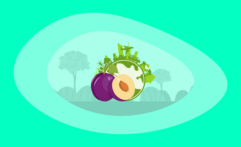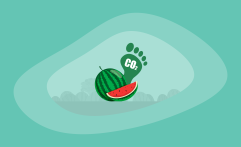The Environmental Impact of Papayas: From Farm to Table
Impactful Ninja is reader-supported. When you buy through links on our site, we may earn an affiliate commission.
Learn more
Learn more
.
Hey fellow impactful ninja ? You may have noticed that Impactful Ninja is all about providing helpful information to make a positive impact on the world and society. And that we love to link back to where we found all the information for each of our posts. Most of these links are informational-based for you to check out their primary sources with one click. But some of these links are so-called "affiliate links" to products that we recommend. First and foremost, because we believe that they add value to you. For example, when we wrote a post about the environmental impact of long showers, we came across an EPA recommendation to use WaterSense showerheads. So we linked to where you can find them. Or, for many of our posts, we also link to our favorite books on that topic so that you can get a much more holistic overview than one single blog post could provide. And when there is an affiliate program for these products, we sign up for it. For example, as Amazon Associates, we earn from qualifying purchases. First, and most importantly, we still only recommend products that we believe add value for you. When you buy something through one of our affiliate links, we may earn a small commission - but at no additional costs to you. And when you buy something through a link that is not an affiliate link, we won’t receive any commission but we’ll still be happy to have helped you. When we find products that we believe add value to you and the seller has an affiliate program, we sign up for it. When you buy something through one of our affiliate links, we may earn a small commission (at no extra costs to you). And at this point in time, all money is reinvested in sharing the most helpful content with you. This includes all operating costs for running this site and the content creation itself. You may have noticed by the way Impactful Ninja is operated that money is not the driving factor behind it. It is a passion project of mine and I love to share helpful information with you to make a positive impact on the world and society. However, it's a project in that I invest a lot of time and also quite some money. Eventually, my dream is to one day turn this passion project into my full-time job and provide even more helpful information. But that's still a long time to go. Stay impactful,Affiliate Disclosure
Why do we add these product links?
What do these affiliate links mean for you?
What do these affiliate links mean for us?
What does this mean for me personally?
![]()
Papayas are a soft, sweet fruit native to Mexico. Today, they are grown everywhere from Florida to Hawaii. Papayas are also highly versatile. For example, they are commonly used in salads, desserts, and ice creams. But the process of growing and distributing papayas can actually have a substantial impact on the environment. So we had to ask: What is the environmental impact of papayas?
Papayas have a fairly negative environmental impact. This is mainly due to their use of styrofoam packaging, monoculture farming, contribution to deforestation, nitrogen fertilizers, and irrigation requirements.
In this article, we will examine the environmental impact of papayas from several different angles. We will go through the life-cycle of papayas, detailing their impact on the environment from growth to distribution to your plate to waste management. We will then compare the environmental impact of papayas to that of other fruits. And, finally, we’ll share some tips with you on how you can reduce your own environmental impact and offset your own carbon emissions – both for your personal life and papaya-related.
Here’s How We Assessed the Environmental Impact of Papayas
The Environmental Impact Assessment (EIA) is one of the ways we measure the potential environmental effects of our actions, like the consumption of papayas. It is a holistic assessment based on the environmental changes associated with our consumption. Those are changes in our environment that can have adverse effects on the air, land, water, fish, and wildlife or the inhabitants of the ecosystem.
“Environmental Impact: the effect that the activities of people and businesses have on the environment”
Cambridge Dictionary
Basically, all goods and services you buy – including papayas – leave an impact on our environment. When it comes to food in general, and papayas in specific, the following are key factors:
- Land requirements: Large parts of the world that were once covered by forests and wildlands are now used for agriculture. 10 million hectares of forest are destroyed annually and 50% of the world’s habitable land is now used for agriculture. This loss of natural habitat has been the main driver for reducing the world’s biodiversity.
- Water footprint: 70% of global freshwater is now used for agricultural purposes. By assessing the water footprint of a particular food, we can determine how our limited freshwater resources are being consumed and polluted.
- Pesticide and fertilizer usage: Pesticides and fertilizers provide a range of agricultural benefits. However, numerous studies link pesticides and fertilizers to serious effects on human health, along with disruptions to vital ecosystems and the spread of aquatic dead zones.
- Carbon footprint: The carbon footprint is one of the ways we measure the effects of our human-induced global climate change. Today, food production accounts for over a quarter (26%) of global greenhouse gas emissions.
- Waste generation: Food and its packaging account for almost 45% of the materials landfilled in the US alone. And packaging sent to landfills, especially when made from plastics, does not degrade quickly or, in some cases, at all.
To understand the overall environmental impact of papayas, we must assess each of their key factors. This Environmental Impact Assessment (EIA) is a tool originally developed to identify the environmental impacts of a project prior to decision-making and also helps us to evaluate the environmental impacts of papayas, from farm to table.
Here’s the Overall Environmental Impact of Papayas
The overall environmental impact of papayas is fairly negative. The main factors that contribute to their environmental impact are the use of nitrogen fertilizer, high irrigation requirements, and use of styrofoam packaging. Their environmental impact is slightly higher than other fruits.
Papayas have a lot of good qualities when it comes to their environmental impact. For one, they use very few pesticides and have very efficient land use. However, many of their more damaging qualities overshadow these positives.
So, let’s have a look at the environmental impact of each key factor of papayas!
| Key Assessment Factors | Environmental Impact |
| Land requirements for papayas | Papayas’ land requirements are fairly low. However, their use of monoculture farming and involvement with deforestation in the Amazon mean their environmental impact is actually quite negative at this stage. |
| Water footprint of papayas | Papayas’ water requirements are high at 50–100 inches of water per year. Because of where they grow in Mexico, they need a significant amount of irrigation to satisfy this requirement. |
| Agrochemical usage for papayas | Papayas’ agrochemical use is moderate. Their pesticide use may be low, but their use of nitrogen fertilizer is particularly damaging to the environment. |
| Carbon footprint of papayas | Papayas have a moderate carbon footprint of 0.3kg (0.67lb) of CO2e per pound of papayas. This is mainly because of their refrigerated shipping from Mexico, use of styrofoam packaging, high irrigation requirements, and low composting rates. |
| Waste generation of papayas | Papayas’ waste generation is very high. This is mostly because they use styrofoam packaging and have low composting rates. |
These are the overall summaries, but there is a lot more to the story. In the next few sections, we will dive deeper into each stage to illustrate to you all the important aspects of papayas’ environmental impact.
What Are the Land Requirements for Papayas
Papayas’ land requirements are fairly low. However, their use of monoculture farming and involvement with deforestation in the Amazon mean their environmental impact is actually quite negative at this stage.
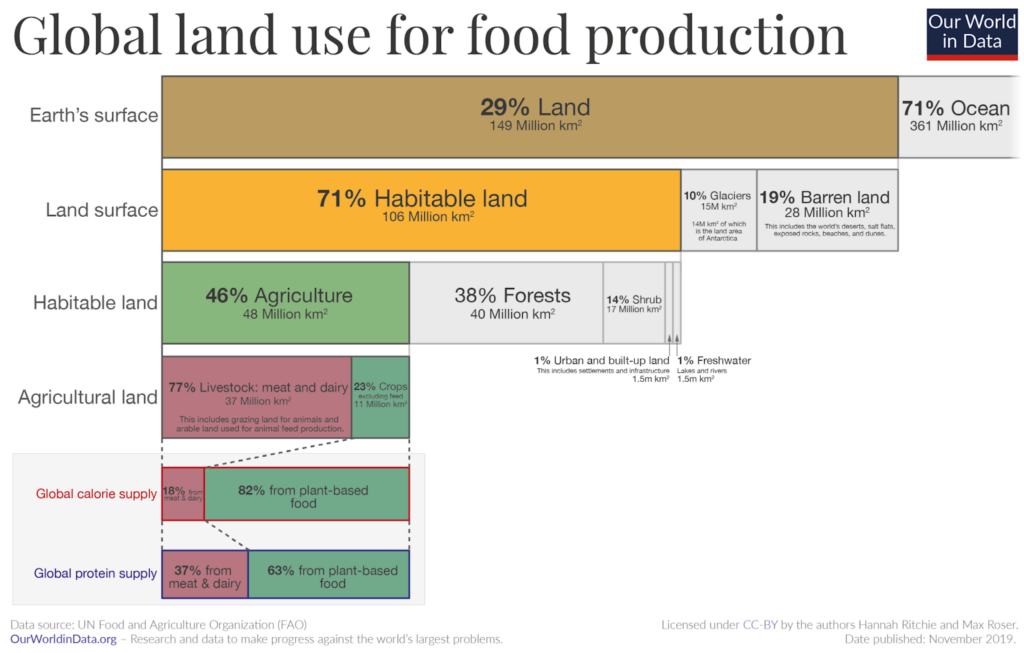
Growing papayas has a lot of variables that contribute to their environmental impact. The amount of land they use, the way in which they grow, and the amount of time they take to grow will all contribute to their environmental impact.
How do the land requirements of papayas impact their environmental footprint?
- What is the land usage of papayas: Papayas yield around 60–75 tons per hectare. This is on the high end amongst fruits. Papayas are only overshadowed by bananas and pineapples, which can both yield up to 100 tons per hectare. Their high growth yield means that papayas use land very economically and so their land efficiency does not contribute significantly to their environmental impact.
- Where and how are papayas grown: Most papayas are grown in India on a global scale. Papayas grow on small trees in subtropical climates. These trees have excellent carbon sequestering properties. When trees sequester carbon, they essentially capture carbon from the atmosphere and store it in the ground, reducing the amount of carbon in the air. This is very good for papayas’ carbon footprint and thus good for their environmental impact.
- How does the growing of papayas affect soil fertility and erosion: Papaya farming has caused significant damage to soils, mainly through their use of irrigation and fertilization. Both irrigation and certain fertilizers can cause serious environmental damage in many different ways, such as soil fertility.
- How does the papayas industry affect the loss of habitable land: Though India is the biggest producer of papayas, there is still a significant amount produced in Brazil. Brazil is home to the Amazon rainforest, one of the largest carbon sinks in the world. So, this area is particularly vulnerable to deforestation, especially due to agriculture. Papayas have been identified as one of the drivers of current Amazon deforestation, meaning their cultivation actively contributes to one of the most notorious deforestation zones on the planet.
- How does the papayas industry affect wildlife and biodiversity: The wildlife of the Amazon have been seriously harmed by agricultural deforestation. Papayas are also grown in monocultures, which are particularly harmful to biodiversity. The shorter pollination times within monoculture farms mean that pollinators like bees and butterflies are malnourished throughout the year. Papayas’ use of monoculture farming, as well as their cultivation on former rainforest land means they have a very negative impact on wildlife and biodiversity.
In short, papayas have a fairly negative environmental impact at this stage. They use some harmful agricultural practices like monoculture farming, and contribute to Amazon deforestation.
What Is the Water Footprint of Papayas
Papayas’ water requirements are high at 50–100 inches of water per year. Because of where they grow in Mexico, they need a significant amount of irrigation to satisfy this requirement.
Water usage is one of the most important factors in the environmental impact of a fruit. The amount of water used, as well as the way they affect the water sources around them, are all major contributing factors. Here, we will look at these different angles to papayas’ water impact.
How does the water footprint of papayas impact their environmental footprint?
- What is the overall water usage of papayas: Papayas need 50–100 inches of water per year. This is a fairly high water usage amongst fruits. For example, cherries only need around 35 inches of water per year. Therefore, papayas’ water footprint is considerably high.
- What is the green water footprint of papayas: The green water footprint is the amount of water from precipitation stored in the soil and used by plants for growth. Most papayas consumed in the US are grown in Mexico, which only gets around 28 inches of rain per year. This does not cover papayas’ water requirement, which means that the vast majority of rainfall in the area will go towards papaya growth.
- What is the blue water footprint of papayas: The blue water footprint is the amount of water sourced from surface (such as rivers or lakes) or groundwater resources. Since Mexicos’ annual rainfall is lower than the amount they need to grow, papayas will require significant irrigation. Therefore, papayas have a very high blue water footprint.
- What is the gray water footprint of papayas: The gray water footprint is the amount of freshwater required to clean up water pollution to meet certain quality standards. Essentially, it’s the amount of water needed to make polluted water clean enough to be safe and healthy for humans and the environment. Papayas use very few pesticides and so very little water is needed to clean up their pollution. For this reason, papayas have a very low gray water footprint.
- How does the papayas industry affect freshwater and ocean pollution: Irrigation has a very negative environmental impact, mainly due to disturbing groundwater balance and causing oversalination.
In short, papayas’ high use of irrigation means that their water impact is very high. This is true despite their gray water footprint being low.
What Is the Agrochemical Usage for Papayas
Papayas’ agrochemical use is moderate. Their pesticide use may be low, but their use of nitrogen fertilizer is particularly damaging to the environment.
Pesticides and fertilizers are agrochemicals that can have a significant impact on the environment. They both require resources to create as well as have effects on the life around them. Here, we will look at how papayas’ pesticide and fertilizer rates affect their environmental impact.
How does the agrochemical usage of papayas impact their environmental footprint?
- What is the pesticide usage of papayas: Papayas use a very low amount of pesticides. Because of this, they avoid many of the significant environmental damages that pesticides can cause.
- What is the fertilizer usage of papayas: Papayas primarily use nitrogen fertilizer in their growth process. Nitrogen is one of the more damaging fertilizers. Therefore, papayas’ fertilizer use contributes very negatively to their environmental impact.
- Are there any known issues connected to the agrochemical usage for papayas: Nitrogen fertilizer has several major issues associated with it. One of its biggest issues is the promotion of invasive algae growth, which can harm many kinds of aquatic life.
In short, the fact that papayas are fertilized with nitrogen is a big contributor to their environmental impact, despite the fact that their pesticide usage is very low.
What Is the Carbon Footprint of Papayas
Papayas have a moderate carbon footprint of 0.3kg (0.67lb) of CO2e per pound of papayas. This is mainly because of their refrigerated shipping from Mexico, use of styrofoam packaging, high irrigation requirements, and low composting rates.
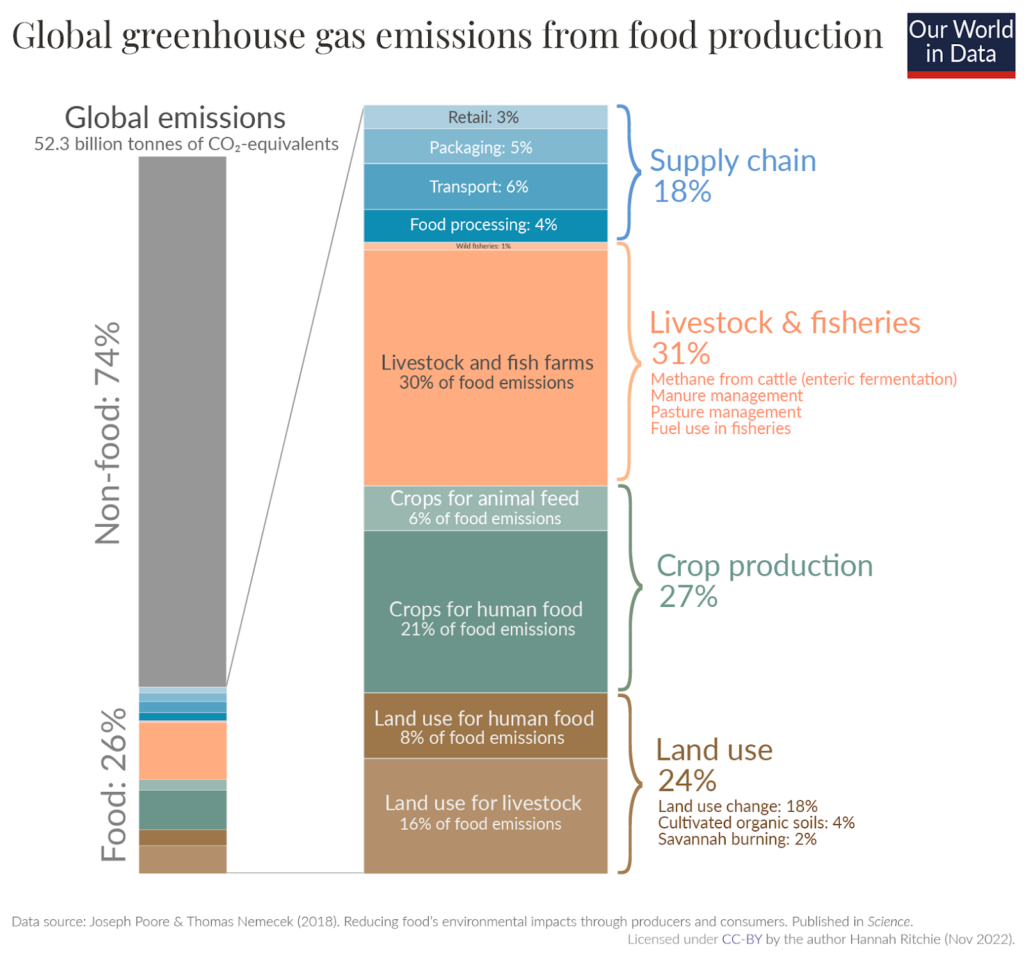
Carbon footprint is one aspect of the overall environmental impact of a fruit. It essentially measures how much carbon or other greenhouse gasses the production of papayas emits into the atmosphere. Emissions from product manufacturing, irrigation, transportation fuel, and landfills all add up to create the overall carbon footprint of a fruit. Let’s see how the carbon footprint of papayas breaks down and contributes to their environmental impact.
How does the carbon footprint of papayas impact their environmental footprint?
- What is the overall carbon footprint of papayas: The overall carbon footprint of papayas is 0.3kg (0.67lb) of CO2e per pound of papayas. This means that for every pound of papayas produced, 0.3kg of carbon (or carbon-equivalent gasses) is released into the atmosphere. This is a fairly average carbon footprint compared to other fruits.
- What are the main contributors to the carbon footprint of papayas: The main factors that contribute to papayas’ carbon footprint are the use of styrofoam packaging, international refrigerated shipping, and their high irrigation needs.
- Which life-cycle stage of papayas has the highest carbon footprint: The stage that contributes the most to papayas’ carbon footprint is waste management. This is mainly because they use styrofoam packaging, which is notoriously hard to recycle. They also have low composting rates for their food waste.
In short, papayas’ use of refrigerated shipping, styrofoam packaging, and excessive irrigation all combine to create a significant carbon footprint.
What Is the Waste Generation of Papayas
Papayas’ waste generation is very high. This is mostly because they use styrofoam packaging and have low composting rates.
When fruit waste, either packaging or organic materials, is disposed of, it can have a major impact on the environment. Whether it’s damaging wildlife, getting into oceans, emitting methane, or dissolving into microplastics that contaminate groundwater, all these materials have their part to play. In this section, we will look at how papayas’ waste affects the environment.
How does the waste generation of papayas impact their environmental footprint?
- What is the packaging of papayas: Papayas are generally packaged using cardboard for the boxes and styrofoam for the cushioned sleeves. Cardboard has a negative environmental impact during its manufacturing process, mainly by contributing to deforestation. Styrofoam also has a negative impact, creating toxic chemicals in its production. As a result, simply creating the packaging for papayas has a significantly negative environmental impact.
- How is the packaging of papayas disposed of: Cardboard and styrofoam can both technically be recycled, but they have vastly different recycling rates. Cardboard’s recycling rate is very high, with around 89% of cardboard being successfully recycled. Styrofoam, however, has a much lower recycling rate of less than 1%. Therefore, the majority of papayas’ styrofoam packaging is ending up in landfills. Landfills cause a lot of environmental damage, including high greenhouse gas emissions, chemical runoff, and land clearing. The fact that almost all of papayas’ styrofoam packaging goes into landfills is very bad for their environmental impact.
- How are papayas disposed of: Papayas have peels that are generally not eaten. These are technically compostable, but since only 4% of food is actually composted, they are likely to end up in landfill. Furthermore, when food is put in landfill, food waste creates methane, heightening the negative environmental impact of landfills.
In short, papayas’ use of styrofoam in their packaging is not good for their environmental impact. Pair that with their low composting rates and their waste disposal impact is very high.
What Have Been Historical Environmental Issues Connected to the Papayas Industry
The papaya industry has historically contributed to deforestation and groundwater pollution through their Amazon land clearing and use of harmful nitrogen fertilizers.
All fruits have had a complex road toward global distribution. They originate in one part of the world and often travel far to end up in your local supermarket. From farm to table, some of our favorite fruits have racked up some serious environmental damage along the way. Whether it’s deforestation to meet demand, water pollution, or disruption of wildlife, most fruits have left a path of destruction. Let’s see how papayas have fared throughout history.
What have been the key environmental issues of the papayas industry?
- How much land has been lost because of papayas production: Papaya farming has been long associated with deforestation, especially when cultivated in Brazil. In 2015, it was estimated that 204 hectares of the Amazon rainforest was deforested specifically to cultivate papayas. This, combined with the fact that the papaya industry is set to grow in the coming years means that their destruction of the Amazon is likely to continue.
- Which wildlife species have been negatively impacted or displaced because of papayas production: The Amazon rainforest is home to millions of species, over 10,000 of which are currently at risk of extinction. Many of these animals have experienced unprecedented habitat loss specifically to do with agricultural land clearing. Some of these species include jaguars, river dolphins, and poison dart frogs.
- Have water sources and soil been contaminated because of papayas production: Nitrogen fertilizer has been long associated with soil, groundwater, and freshwater pollution. It is particularly known for promoting invasive algae growth, which is damaging to the ecosystem.
In short, papaya agriculture has historically caused serious harm to the environment. This is mainly due to Amazon deforestation and use of nitrogen fertilizer.
What Is the Overall Environmental Impact of Food and Agriculture
Food production in general has a high environmental impact. Everything from the amount of land used to the energy involved in irrigation to its effect on plant and animal biodiversity can be a factor in this. In the chart below, you can see how food production is one of the biggest influences on these areas of the environment.
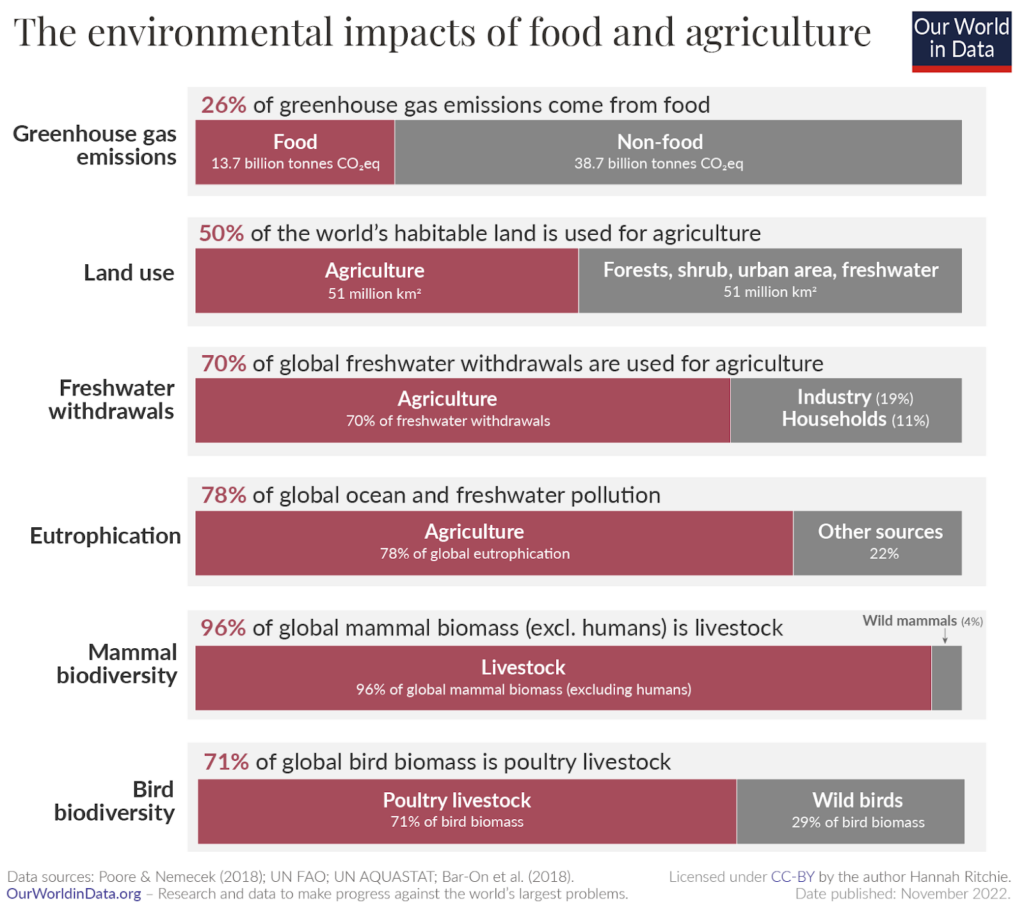
Agriculture alone accounts for over a quarter of global greenhouse gas emissions, while using half of the world’s habitable land and 70% of the global freshwater withdrawals. Agriculture also causes 78% of the global ocean and freshwater pollution.
Livestock accounts for the vast majority of non-human mammal and bird biomass. Mammal livestock outweighs wild mammals by a factor of 15-to-1, and poultry livestock outweighs wild birds by a factor of more than 3-to-1.
These statistics highlight the need for sustainable and responsible practices in food production to reduce its impact on the environment. And the need for us to shift toward more environmentally-friendly foods.
How Can You Reduce Your Environmental Impact and Offset Your Personal Carbon Footprint
There are a few things you can do to mitigate some of the negative environmental effects of consuming papayas, while still enjoying them. You can also consider offsetting your personal and papaya-related carbon emissions, which work to remove carbon emissions elsewhere that are then attributed to you. Here, we will walk you through how to accomplish both of these things.
How Can You Reduce Your Environmental Impact When Shopping for Papayas
In this section, we give you a short list of ways you can reduce the negative environmental effects of papayas, based on those parts of the life-cycle of papayas that would otherwise most negatively impact the environment:
- Avoid packaging: Considering the low recycling rates, especially for styrofoam, packaging contributes significantly to papayas’ environmental impact. If you try to avoid packaging as much as possible, you will not only be reducing the pollution involved in creating the packaging, but also the pollution associated with landfill waste.
- Buy organic papayas: Though papayas have lower pesticide rates, their use of nitrogen fertilizer is one of the leading contributors to their negative environmental impact. Organic farms generally avoid nitrogen fertilizers and so they are good to support if you want to reduce your fertilizer impact.
- Use the whole papaya: Papaya peels might not be very tasty, but they can actually be very useful! There are many ways to use them that can help them avoid the landfill. One way is to use them for skincare by creating a papaya face mask. These extra uses can really help to cut down on waste and maximize usage. Plus, it avoids you buying a store-bought face mask which would likely come with plastic packaging!
Following some of these methods can really help you to cut down on your environmental impact of eating papayas. None of these will completely eradicate these negative impacts, since there are always effects that may be outside of your control. But some reduction is always better than nothing!
Which Organizations Can You Support to Help Alleviate Your Environmental Impact
While papayas can cause a wide range of environmental damage, there are also some organizations that help you reduce parts of your impact that would otherwise be outside of your control. These organizations are working hard to prevent and reverse damage to the environment caused by industries like papayas agriculture.
In the table below are some of the best environmental charities that work in the areas where papayas production has affected the environment – and beyond:
Though it is helpful to reduce the environmental impact of your personal papayas consumption, supporting these organizations takes your positive impact a step further. You will be reaching far beyond your own consumption impacts and helping to build a better world for everyone!
How Can You Offset Your Personal Carbon Footprint
The carbon footprint is a key part of your environmental impact. And it is one of the ways we measure the effects of our human-induced global climate change. Yes, even from eating papayas!
“Carbon footprint: the amount of greenhouse gasses and specifically carbon dioxide emitted by something (such as a person’s activities or a product’s manufacture and transport) during a given period”
Merriam Webster
Basically, it is the amount of carbon emitted by you as an individual or an organization providing you with goods and services – including papayas:
- This includes GHG emissions from producing the products that we use and foods that we eat (e.g., power plants, factories or farms, and landfills)
- GHG emissions from fuel that we burn directly or indirectly (e.g., logistics and transportation, cooling or heating facilities),
- as well as the GHG emissions attributed to how we consume these products and foods.

Carbon offsets are reductions in carbon emissions that are used to compensate for carbon emissions occurring elsewhere – for example for the carbon emissions that are associated with papayas. They are measured in tons of CO2 equivalents and are bought and sold through international brokers, online retailers, and trading platforms on what is known as the global carbon offset market.
“Carbon Offset: a way for a company or person to reduce the level of carbon dioxide for which they are responsible by paying money to a company that works to reduce the total amount produced in the world, for example by planting trees”
Oxford Dictionary
In terms of papayas – and indeed all food types – there will always be a carbon footprint, because of the resources it takes to get your food from farms to the place where you’ll eventually eat them. And while there are ways to reduce your carbon footprint when shopping for papayas, carbon offsets would be a way to reduce your CO2e emissions all the way down to net zero (or even to become climate positive).
However, when you purchase carbon offsets, it’s important that they actually make a difference in offsetting (aka reducing) total carbon emissions. To achieve that, the following are key criteria:
- Carbon offset projects have to be effective (different projects have different effectiveness rates)
- Carbon offset projects have to be additional
- Carbon offset projects have to be permanent
- The claims from carbon offset projects have to be verifiable
To find the best carbon offsets for you personally, check out our full guide on the best carbon offsets for individuals, where you’ll also learn more about how these carbon offset projects work, what their respective offsetting costs are, and what your best way would be to offset your own carbon emissions.
Final Thoughts
Papayas have some pros and cons when it comes to their environmental impact. For example, they have excellent carbon-sequestering abilities, they don’t use a significant amount of pesticides, and their land use is very economical. However, they also use nitrogen fertilizer, contribute to Amazon deforestation, use styrofoam packaging, and require a significant amount of irrigation. But by following some reduction tips and supporting environmental organizations, you can help to mitigate some of these more damaging impacts of consuming papayas.
Stay impactful,

Sources
- Medical News Today: Papaya Fruit
- DPI: Papaya Fact Sheet
- BBC Good Food: Papaya Bean Sprout Salad
- Insanely Good Recipes: Papaya Desserts
- Good Food Baddie: Tropical Papaya Ice Cream
- UN Environment Programme: Environmental Impact Assessment and Strategic Environmental Assessment: Towards an Integrated Approach
- Our World in Data: The environmental impacts of food and agriculture
- Our World in Data: Global land use for food production
- World Health Organization: Preventing disease through healthy environments: a global assessment of the burden of disease from environmental risks
- ScienceDirect (Biological Conservation): Worldwide decline of the entomofauna: A review of its drivers
- EPA: The Sources and Solutions: Agriculture
- EPA: Reducing Food Waste and Packaging
- FoodPrint: The Environmental Impact of Food Packaging
- Epic Gardening: Papaya Trees
- Impactful Ninja: What is the Carbon Footprint of Papayas
- Government of Tripura: Cultivation Techniques of Papaya
- Impactful Ninja: What is the Carbon Footprint of Bananas
- Impactful Ninja: What is the Carbon Footprint of Pineapples
- WIFSS: Papayas
- Plantura: Papaya: Growing From Seed
- Text Road: The Role of Plant Tillers Toward Carbon Sequestration
- Green Matters: How do Carbon Emissions Affect the Environment
- African Journal of Agricultural Research: Environmental Impact Assessment of Irrigated Papaya
- National Geographic: Environmental Impact of Agricultural Modification
- Mitsui: Reducing the Impact of Chemical Fertilizers
- Fruteiro: Brazilian Tropical Fruits
- WWF: Mechanized Agriculture
- Amazon Conservation: Patterns and Drivers of Deforestation in the Peruvian Amazon
- World Population: Deforestation Rates by Country
- WWF: Wildlife Conservation in the Amazon
- 1001 Artificial Plants: 6 Effects of Monoculture System on Biodiversity
- Gardening Knowhow: How to Water a Cherry Tree
- Water Footprint Network: What Is a Water Footprint?
- Climate Knowledge Portal: Mexico Climate Data
- Epic Gardening: Papaya Tree
- Healthline: The Clean Fifteen
- FAO: Environmental Considerations in Irrigation Development
- GOV.BC: Environmental Protections and Pesticides
- Garden Guides: Papaya Tree Fertilizer
- EPA: The Issue With Nitrogen Fertilizer
- ITF Net: Papaya Postharvest Processing
- Insider: Is Styrofoam Recyclable?
- EPA: Reducing the Impact of Wasted Food
- TRVST: The Environmental Impact of Cardboard
- CEHN: Styrofoam FAQ
- Also Known As: 12 Interesting Facts About Packaging Waste
- GOV.BC: Waste Management
- MAAP: Papaya Peru
- Technavio: Papaya Market Industry Analysis
- Reuters: 10000 Species At Risk of Extinction in the Amazon
- Earth.org: 8 Amazon Species At Risk of Extinction
- SN Applied Sciences Journal: Worldwide pesticide usage and its impacts on ecosystem
- Our World in Data: Global greenhouse gas emissions from food production
- Our World in Data: The environmental impacts of food and agriculture
- UVM: Organic Farmers
- Herzindagi: Papaya Peels Can Give Your Face a Natural Glow
- Impactful Ninja: Best charities that fight to protect our environment
- Impactful Ninja: Best charities for reforestation
- Impactful Ninja: Best wildlife conservation charities
- Impactful Ninja: Best charities for protecting the Amazon rainforest
- Impactful Ninja: Best charities that protect our national parks
- Impactful Ninja: Best charities that fight for clean water
- Impactful Ninja: Best charities that help conserve our rivers
- Impactful Ninja: Best charities to save our oceans
- Impactful Ninja: Best charities that help farmers
- Impactful Ninja: Best charities for helping farm animals
- Impactful Ninja: Best charities for climate change
- Impactful Ninja: Best carbon offsets for individuals
- Impactful Ninja: Best charities that fight to reduce food waste
- Impactful Ninja: Best charities that fight to end plastic pollution
- Our World in Data: Emissions from food alone would take us past 1.5°C or 2°C this century
- Impactful Ninja: Why Is a Carbon Footprint Bad for the Environment
- Impactful Ninja: Best Carbon Offsets for Individuals
